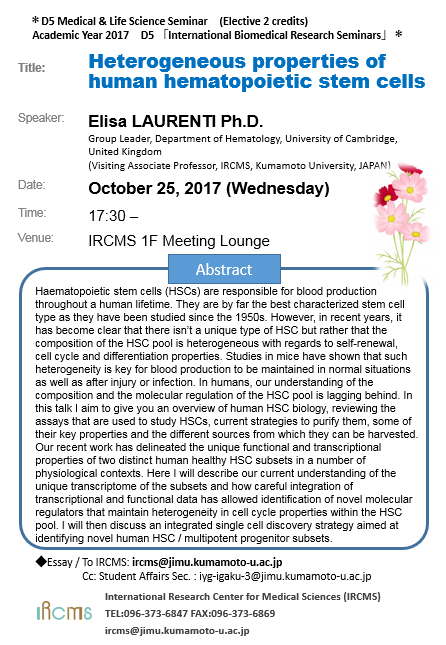- HOME
- News & Events
- *D5 Medical & Life Science Seminar*
News & Events
*D5 Medical & Life Science Seminar*
October 25 2017
We would like to inform you that the "D5 Medical & Life Science Seminar AY 2017 D5 「International Biomedical Research Seminars」" has been scheduled as below. We would be pleased to see many of you participating in the seminar.
Date: October 25, 2017 (Wed) Time: 17:30 -
Venue: IRCMS 1F Meeting Lounge
Speaker: Elisa LAURENTI Ph.D.
Group Leader, Department of Hematology, University of Cambridge, United Kingdom
Visiting Associate Professor, IRCMS, Kumamoto University, Japan
"Heterogeneous properties of human hematopoietic stem cells"
Haematopoietic stem cells (HSCs) are responsible for blood production throughout a human lifetime. They are by far the best characterized stem cell type as they have been studied since the 1950s. However, in recent years, it has become clear that there isn't a unique type of HSC but rather that the composition of the HSC pool is heterogeneous with regards to self-renewal, cell cycle and differentiation properties. Studies in mice have shown that such heterogeneity is key for blood production to be maintained in normal situations as well as after injury or infection. In humans, our understanding of the composition and the molecular regulation of the HSC pool is lagging behind. In this talk I aim to give you an overview of human HSC biology, reviewing the assays that are used to study HSCs, current strategies to purify them, some of their key properties and the different sources from which they can be harvested. Our recent work has delineated the unique functional and transcriptional properties of two distinct human healthy HSC subsets in a number of physiological contexts. Here I will describe our current understanding of the unique transcriptome of the subsets and how careful integration of transcriptional and functional data has allowed identification of novel molecular regulators that maintain heterogeneity in cell cycle properties within the HSC pool. I will then discuss an integrated single cell discovery strategy aimed at identifying novel human HSC / multipotent progenitor subsets.

